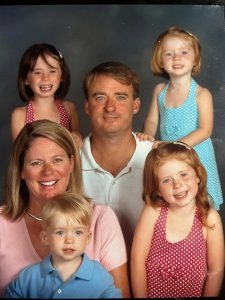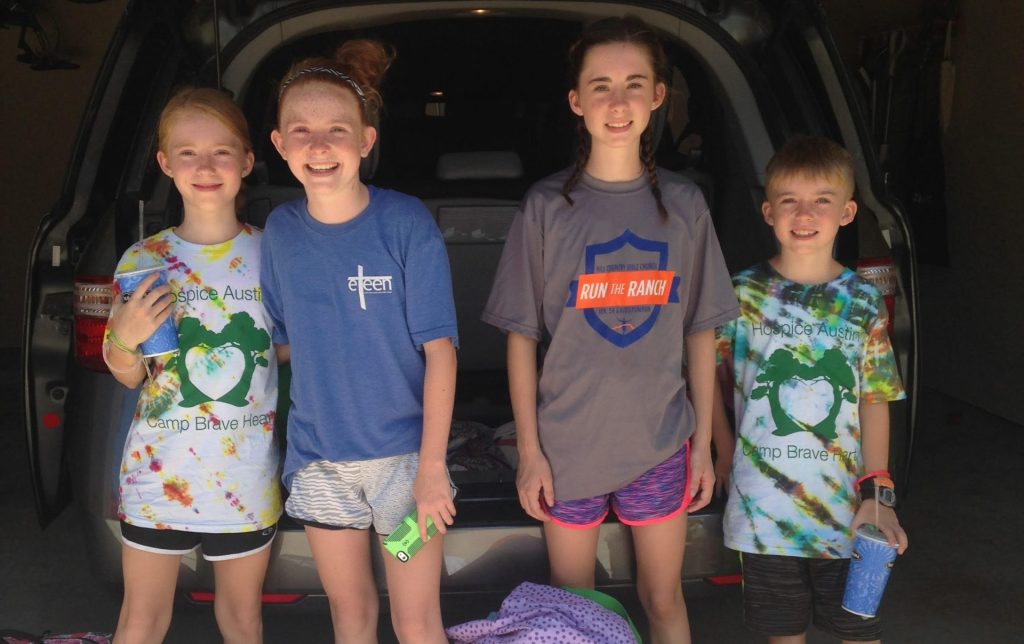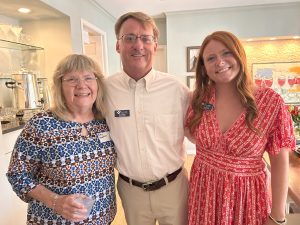
Portrait of the Brown Family
I’m not a grief expert. I’m simply someone who’s lived through loss and found healing—and now I have the privilege of sharing my journey in hopes of reaching others walking a similar path. My personal connection to Hospice Austin began long before I started interning there this summer.
In 2015, my mom died unexpectedly, leaving my dad and four heartbroken children—ages 8, 10, 12, and 14—shattered by a loss we never saw coming.
There’s no book, no perfect words to help you fully comprehend what’s happened, or how much your world is about to change. My mom was incredibly hands-on and loving, we were all extremely close with her, and our family was very connected, something I will always be deeply grateful for. We had never experienced a loss like this before. Knowing that the most important person in our young lives wouldn’t be there anymore, was absolutely devastating.
She was a stay-at-home mom, so we spent nearly every day with her. She was involved in every part of our lives and was truly the glue that held our busy family together.
“The shock of losing her is something I still struggle to put into words.”
When we got the news, we all went numb. We didn’t know what to do or how to move forward. Losing a parent at any age is heartbreaking, but for young children, it can feel world-ending. We still needed our mom.
When you’re young, you imagine growing up with your mom by your side through life’s biggest moments—prom, graduations, weddings, even late-night talks and advice. I never expected those memories to be stripped away before they even had a chance to happen. At first, I felt more anger and confusion than sadness: angry that this was happening to us, confused that someone so kind and full of life could be taken so soon. I couldn’t see how we’d ever move forward—how we’d return to school, to routines, to anything that once felt normal. Simply going out into the world felt impossible. I’d spot her car or pass her favorite restaurant and feel the weight of grief pressing in, but I refused to break down, because I wanted to stay strong for my family.
In my household, there are five of us, each with very different personalities. So, when it came to grieving, we each handled it in our own way. The four of us kids were grieving the loss of our mother, and my dad was grieving the loss of his wife. We had all lost the same person, but our relationships with her were different, so our grief looked different, too. Even among my siblings and I, we each had very different ways of processing our emotions.
What helped us cope was individual counseling and then learning how to support one another’s needs and feelings. I’d be lying if I said it was easy—there were definitely some rocky years in between, and it honestly took time for emotions to settle and for us to grow.
Thankfully, my dad acted swiftly in getting us support. He found counselors and community resources to guide us through the grieving process. One of those resources was Hospice Austin and their bereavement support. My family’s connection to Hospice Austin began in 2016, one year after my mom had passed and my dad signed us up for Hospice Austin’s Camp Brave Heart.

Mary Cate ( second from left) and her siblings coming home from Camp Brave Heart
Before camp, the only people who really understood what I was experiencing were my siblings. Kids at school didn’t get it. And while I was thankful for my siblings’ support, we needed to connect with others outside our bubble.
Each of us grieved differently, and we were all hesitant to go to camp. We didn’t want to be separated from our dad and the idea of going to a camp centered around the concept of death wasn’t appealing. Our feelings were valid, but we couldn’t have been more wrong about what Camp Brave Heart would be like. It was so beneficial for us to get out and just be kids, while also having those moments sitting down with others and sharing our experiences.
Camp Brave Heart changed my entire perspective on grief. It wasn’t until I was sitting around a campfire with my group that I finally opened up about my story. It was like I could finally breathe. That night was the first time I truly felt comfortable sharing, not just with others, but with myself. Seeing others around me open up is what inspired me to do the same. I shared my story, my feelings, and my emotions. I just talked and talked about my mom, how it happened, how I felt, what my reactions were. I unraveled it all. And for the first time, I felt heard. The other kids didn’t get awkward or uncomfortable, instead, they asked me questions. They encouraged me to dig deeper and express myself. They weren’t afraid of the conversation, and that gave me strength to continue to share my story.
“That early support planted the seeds of resilience.”
Over the years, I’ve seen just how much my experience with grief has changed from when I was younger to now. When I lost my mom, I was 12. Now I’m 22. Our family has come so far. We think about her all the time, but we now have the skills and support to make it through those difficult moments.

Betty Stephens, with Board Member Steve Brown and daughter, Mary Cate Brown at Hospice Austin’s Notable Donor Reception.
Over the years, I’ve participated in panel discussions for Hospice Austin, and have appeared in several news stories for them, and now, I’m honored to be part of Hospice Austin’s Development team for the summer.
Ten years after my mom’s death, I’m serving in the very organization that helped me find my voice. I was recently able to speak at a donor event and share my story in ways I hope inspires others. Expressing gratitude to donors in person has been one of the most meaningful parts of this role—they don’t always get to see the lives they’ve touched, and I’m proud to be living proof of their impact.
Grief doesn’t follow a linear path. But if my experience has taught me anything, it’s that healing is possible—and often, it begins with finding the courage to ask for help. I’m endlessly grateful to Hospice Austin for helping me take that first step.




